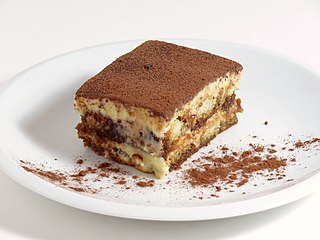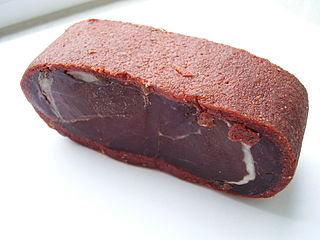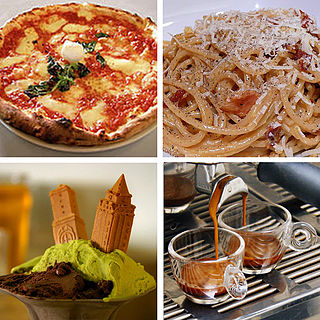
Pizza is a traditional Italian dish typically consisting of a flat base of leavened wheat-based dough topped with tomato, cheese, and other ingredients, baked at a high temperature, traditionally in a wood-fired oven.

A submarine sandwich, commonly known as a sub, hoagie, hero, Italian, grinder, wedge, or a spuckie, is a type of American cold or hot sandwich made from a cylindrical bread roll split lengthwise and filled with meats, cheeses, vegetables, and condiments.

Tiramisu is an Italian dessert made of ladyfinger pastries (savoiardi) dipped in coffee, layered with a whipped mixture of eggs, sugar and mascarpone and flavoured with cocoa. The recipe has been adapted into many varieties of cakes and other desserts. Its origin is disputed between the Italian regions of Veneto and Friuli-Venezia Giulia. The name comes from the Italian tirami su.

A sausage is a type of meat product usually made from ground meat—often pork, beef, or poultry—along with salt, spices and other flavourings. Other ingredients, such as grains or breadcrumbs, may be included as fillers or extenders.

Gnocchi are a varied family of dumplings in Italian cuisine. They are made of small lumps of dough, such as those composed of a simple combination of wheat flour, potato, egg, and salt. Variations of the dish supplement the simple recipe with flavour additives, such as semolina flour, cheese, breadcrumbs, cornmeal or similar ingredients, and possibly including herbs, vegetables, and other ingredients. Base ingredients may be substituted with alternatives such as sweet potatoes for potatoes or rice flour for wheat flour. Such variations are often considered to be non-traditional.

Sauerkraut is finely cut raw cabbage that has been fermented by various lactic acid bacteria. It has a long shelf life and a distinctive sour flavor, both of which result from the lactic acid formed when the bacteria ferment the sugars in the cabbage leaves.

Pesto or more fully pesto alla genovese is a paste made of crushed garlic, pine nuts, salt, basil leaves, grated cheese such as Parmesan or pecorino sardo, and olive oil. It originated in the Italian city of Genoa, and is used to dress pasta and sometimes soups.

Carbonara is a pasta dish made with fatty cured pork, eggs, hard cheese, salt, and black pepper. It is typical of the Lazio region of Italy. The dish took its modern form and name in the middle of the 20th century.

Maghreb cuisine is the cooking of the Maghreb region, the northwesternmost part of Africa along the Mediterranean Sea, consisting of the countries of Algeria, Libya, Mauritania, Morocco, and Tunisia. Well-known dishes from the region include couscous, pastilla, tajine and shakshouka.

Focaccia is a flat leavened oven-baked Italian bread. In some places, such as Rome, it is similar to a style of pizza called pizza bianca. Focaccia may be served as a side dish or as sandwich bread and it may be round, rectangular, or square shape.

Steak tartare or tartar steak is a French dish of raw ground (minced) beef. It is usually served with onions, capers, mushrooms, pepper, Worcestershire sauce, and other seasonings, often presented separately, to be added to taste. It is often served topped with a raw egg yolk. It is similar to the Levantine kibbeh nayyeh, the Turkish çiğ köfte and the Korean yukhoe.

Pastirma or Pasterma, also called pastarma,pastırma,pastourma, basdirma, basterma, basturma, or aboukh is a highly seasoned, air-dried cured beef that is found in the cuisines of Albania, Armenia, Romania, Bulgaria, Egypt, Greece, Cyprus, Iraq, the Levant, North Macedonia, Azerbaijan, and Turkey.

A flatbread is bread made usually with flour; water, milk, yogurt, or other liquid; and salt, and then thoroughly rolled into flattened dough. Many flatbreads are unleavened, although some are leavened, such as pita bread.

Bottarga is a delicacy of salted, cured fish roe pouch, typically of the grey mullet or the bluefin tuna. The best-known version is produced around the Mediterranean; similar foods are the Japanese karasumi and Taiwanese wuyutsu, which is softer, and Korean eoran, from mullet or freshwater drum. It has many names and is prepared in various ways.

Pizza Margherita or Margherita pizza is a typical Neapolitan pizza, roundish in shape with a raised edge and garnished with hand-crushed peeled tomatoes, mozzarella, fresh basil leaves, and extra virgin olive oil. The dough is made by mixing water, salt and yeast with flour.

Bagna càuda, also spelled bagna caouda in Alpes-Maritimes, is a hot dish made with garlic and anchovies, typical of Lower Piedmont, a geographical region of Piedmont, Italy, and Provence, France. The dish is served and consumed in a manner similar to fondue, sometimes as an appetizer, with raw or cooked vegetables typically used to dip into it.

Italian cuisine is a Mediterranean cuisine consisting of the ingredients, recipes and cooking techniques developed in Italy since Roman times and later spread around the world together with waves of Italian diaspora. Some of these foods were imported from other cultures. Significant changes occurred with the colonization of the Americas and the introduction of potatoes, tomatoes, capsicums, maize and sugar beet—the latter introduced in quantity in the 18th century. It is one of the best-known and most appreciated gastronomies worldwide.

Sardenaira is a pizza dish, without cheese, from the Liguria region of Italy. It is very similar to the pissaladière. Although termed a pizza, some consider it more akin to a focaccia.

Marinara sauce is a tomato sauce usually made with tomatoes, garlic, herbs, and onions. Variations include capers, olives, spices, and a dash of wine. Widely used in Italian-American cuisine, it is known as alla marinara in Italy, where it is typically made with tomatoes, basil, olive oil, garlic and oregano, but also sometimes olives, capers, and salted anchovies. It is used for spaghetti and vermicelli, but also with meat or fish.

Taralli are toroidal Italian snack foods, common in the southern half of the Italian Peninsula. A wheat-based cracker similar in texture to a grissini breadstick, taralli can be sweet or savory. Sweet taralli are sometimes glazed with sugar. Savory taralli may be flavored with onion, garlic, sesame seeds, poppy seeds, fennel, pepper, chili or just salt. Sweet and plain taralli are often dunked in wine.




















